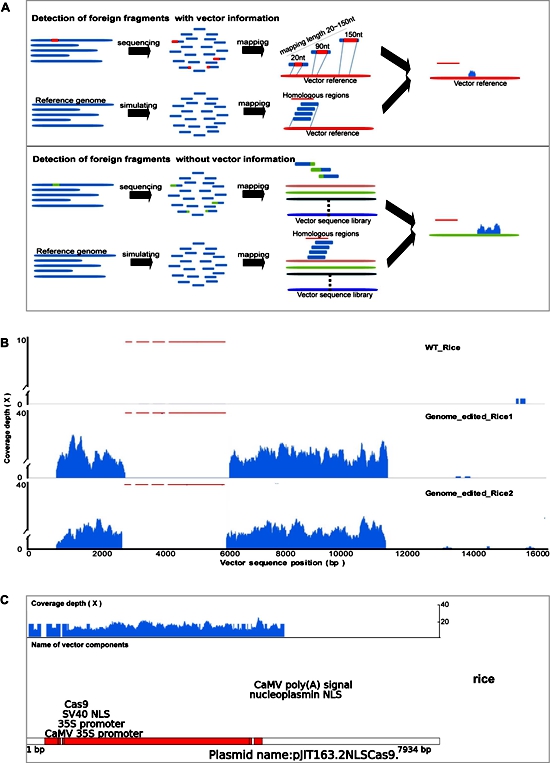CNRRI Scientists Developed a Web Tool for Foreign Element Detection of Genome-Edited Organism
Recently, researchers from China National Rice Research Institute (CNRRI), Chinese Academy of Agricultural Sciences, and Institute of Genetics and Development Biology, Chinese Academy of Sciences jointly reported a web tool named Foreign Element Detector (FED) for foreign element detection of genome-edited organism.
Genome-editing technologies have provided unprecedented tools for genetic improvement. During the process, the DNA cassettes encoding the editing components are usually assembled and delivered into the cells of organisms, which increases the chance of producing unwanted off-target mutations or insertions of plasmid vector components on the genome. Several countries, including the United States, Japan, Canada, Australia, Brazil, and Argentina, have introduced policies assuring for safety of genome-edited products. According to their regulatory framework, only those products detected with no exogenous DNA components can be commercialized on a large scale. At present, PCR or PCR-based methods are the most widely used for detecting these exogenous elements. However, the PCR-based method requires the primers designed for the given sequences. If the primed sequences are mutated or the exogenous elements are fragmented, it would not be able to examine them using the method, leading to a significant false negative rate. Moreover, the PCR-based method can be influenced by experimental conditions, which leads to falsely claimed positive or negative results. Therefore, to ensure the safety of genome-edited products, the screening method suitable for reliably detecting the integration of foreign elements is of critical importance.
Different from the traditional PCR-based method, FED can elucidate the exogenous DNA components with unknown vector information using data derived from the whole genome sequencing. The vector sequence library is composed of 26921 vectors’ sequences with 46695 different components, which hosts reference genome information of 24 most commonly used plants and 13 animals. It is expected that the introduction of this technique would be significant to the application and regulation of genome-edited organism globally.
Supported by the National Transgenic Science and Technology Program (2019ZX08010-003), the National Key Research and Development Program of China (2017YFD0102002), the Agricultural Science and Technology Innovation Program of Chinese Academy of Agricultural Sciences, and the National Natural Science Foundation of China (31901523), the work entitled FED:a Web Tool for Foreign Element Detection of Genome-edited Organism was published online in Science China Life Sciences journal. The exogenous DNA fragments detector is available at http://www.hi-tom.net/.

Link of full paper: http://engine.scichina.com/publisher/scp/journal/SCLS/doi/10.1007/s11427-020-1731-9?slug=abstract.
By Shen Huizhi (shenhuizhi@caas.cn)
-
 Apr 18, 2024Opening Ceremony of the Training Workshop on Wheat Head Scab Resistance Breeding and Pest Control in Africa Held in CAAS
Apr 18, 2024Opening Ceremony of the Training Workshop on Wheat Head Scab Resistance Breeding and Pest Control in Africa Held in CAAS -
 Apr 03, 2024IPPCAAS Co-organized the Training Workshop on Management and Application of Biopesticides in Nepal
Apr 03, 2024IPPCAAS Co-organized the Training Workshop on Management and Application of Biopesticides in Nepal -
 Mar 28, 2024Delegation from the School of Agriculture and Food Science of University College Dublin, Ireland Visit to IAS, CAAS
Mar 28, 2024Delegation from the School of Agriculture and Food Science of University College Dublin, Ireland Visit to IAS, CAAS -
 Mar 25, 2024Director of World Food Prize Foundation visited GSCAAS
Mar 25, 2024Director of World Food Prize Foundation visited GSCAAS -
 Mar 20, 2024Institute of Crop Sciences (ICS) and Syngenta Group Global Seeds Advance Collaborative Research in the Seed Industry
Mar 20, 2024Institute of Crop Sciences (ICS) and Syngenta Group Global Seeds Advance Collaborative Research in the Seed Industry
